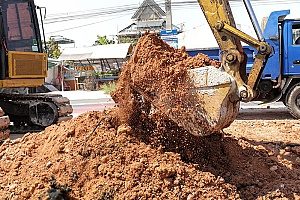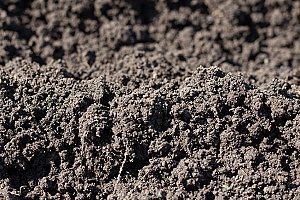 Any construction worker or gardener knows that there is a huge difference in the types of dirt and how each type can be used. When utilizing dirt to complete a landscaping project there are two main types of dirt that differ from one another; topsoil and fill dirt. Knowing the compositional differences between the two types of dirt can help you make the right decision for which one is best for your project. You may find that for the best end result of your project you have to use both types of dirts. This is most often the case when your project involves changing the slope of your yard and growing grass or other plants. For your fill dirt or topsoil delivery, reach out to a Virginia fill dirt contractor for more information and to schedule your fill dirt or topsoil delivery.
Any construction worker or gardener knows that there is a huge difference in the types of dirt and how each type can be used. When utilizing dirt to complete a landscaping project there are two main types of dirt that differ from one another; topsoil and fill dirt. Knowing the compositional differences between the two types of dirt can help you make the right decision for which one is best for your project. You may find that for the best end result of your project you have to use both types of dirts. This is most often the case when your project involves changing the slope of your yard and growing grass or other plants. For your fill dirt or topsoil delivery, reach out to a Virginia fill dirt contractor for more information and to schedule your fill dirt or topsoil delivery.
Fill Dirt vs. Topsoil
Topsoil is the topmost layer of dirt and is full of nutrients and organic matter that make it ideal for growing plants. When it comes to topsoil there are many varieties, and you should choose which soil is right for you based on what you plan to use it for. There are seven different types of soil which include clay soil, silty soil, loamy soil, sandy soil, peaty soil, saline soil, and chalky soil. Each of these soils has a different compositional makeup which makes it better for growing certain plants or flowers, and certain soils perform better in some climates than others. The element of organic matter affects soil based on its quantity within the soil. As organic matter decomposes, it breaks down and releases nutrients that help plants grow and flourish. However, as this organic matter does break down, it can cause the surrounding dirt to shift. A lot of organic matter with make the soil extremely rich in nutrients, but it will also create weak bearing capacities. Having a small amount of organic matter is going to make the soil much more stable, but it will lack the necessary nutrients to support plant growth.
Fill dirt is dirt that lacks all organic matter. Depending on where the dirt is being taken from, this is usually about six inches below the ground. Fill dirt may contain things like sand, rocks, stones, and earth. You want to know that it is certified. Certified fill dirt is safe because it has been screened and verified, so you know the dirt contains no organic matter, toxins, or large debris. If these things were to be in your fill dirt, it could potentially compromise the end result of your project. Fill dirt is most often used to change the grade or elevation of a property to make the area more ideal for its intended use.
 The key difference between the two types of dirt is the presence of organic matter. Topsoil has it, while fill dirt does not. You want to remember that for things like grading, tilling, creating foundations, or creating terraces you want to use fill dirt. If you want to use the dirt to support plant growth, you’re going to want to use topsoil.
The key difference between the two types of dirt is the presence of organic matter. Topsoil has it, while fill dirt does not. You want to remember that for things like grading, tilling, creating foundations, or creating terraces you want to use fill dirt. If you want to use the dirt to support plant growth, you’re going to want to use topsoil.
How To Use Fill Dirt For Your Landscaping Project
For your landscaping project, make sure you’re being extremely detail oriented and picking out the right kind of dirt for each part of your project. One of the ways fill dirt can be utilized is by using it for land grading. In terms of construction, land grading is a process in which land is leveled or sloped to form a base, typically called for when a foundation is needed for a building. Land grading can also be used to correct drainage problems, prevent flooding, fill in low points, level backyard space so the area is more useful, or terrace a property’s hillside yard. You’re going to want to use fill dirt in these instances because it lacks organic matter, making it extremely stable and reliable. Land grading can be used to fix any problems you may be experiencing with your yard, and it can be used to change the appearance of your yard for aesthetic purposes.
Once you have created your desired shape, slope, or foundation with fill dirt, if you’re interested in using the area for growing grass or other plants, you’re going to need to add some topsoil. However, you can’t just throw topsoil over fill dirt and expect your plants to flourish. You need to till the dirt so that there is a gradient from topsoil to fill dirt. This is a process known as tilling. Tilling involves turning over and breaking up the soil. Tilling is usually done when you are mixing amendments into the soil or the soil is too tightly compacted for you to work with. In this instance, your blending some organic matter into the fill dirt so that it doesn’t abruptly end. This is necessary for rainwater drainage and to ensure that you’re plants roots don’t stop growing when they suddenly hit the fill dirt.
An example of when you can use the two kinds of dirts together is if you have a low point in your yard, you can fill it with fill dirt and then lay down topsoil over it so grass or other plants can grow. You could also use fill dirt to create a terrace in your backyard that you can lay topsoil down on so that you can create a flower bed. Using both types of dirt together can help you create your ideal backyard. Fill dirt can give your backyard the shape and slope you desire, while topsoil will help support healthy plants.
Why You Can’t Use Topsoil For Land Grading
 If topsoil is used for foundations or land grading, the project won’t be successful because topsoil contains organic matter. This will result in the volume of the topsoil changing as the breakdown occurs, which could then potentially cause any foundations on top to shift. This is also a problem when it comes to land grading because if you are trying to fill a low point, the low point may be initially filled to be level with the rest of the land, but over time the changing volume of the topsoil will result in the low point returning.
If topsoil is used for foundations or land grading, the project won’t be successful because topsoil contains organic matter. This will result in the volume of the topsoil changing as the breakdown occurs, which could then potentially cause any foundations on top to shift. This is also a problem when it comes to land grading because if you are trying to fill a low point, the low point may be initially filled to be level with the rest of the land, but over time the changing volume of the topsoil will result in the low point returning.









































